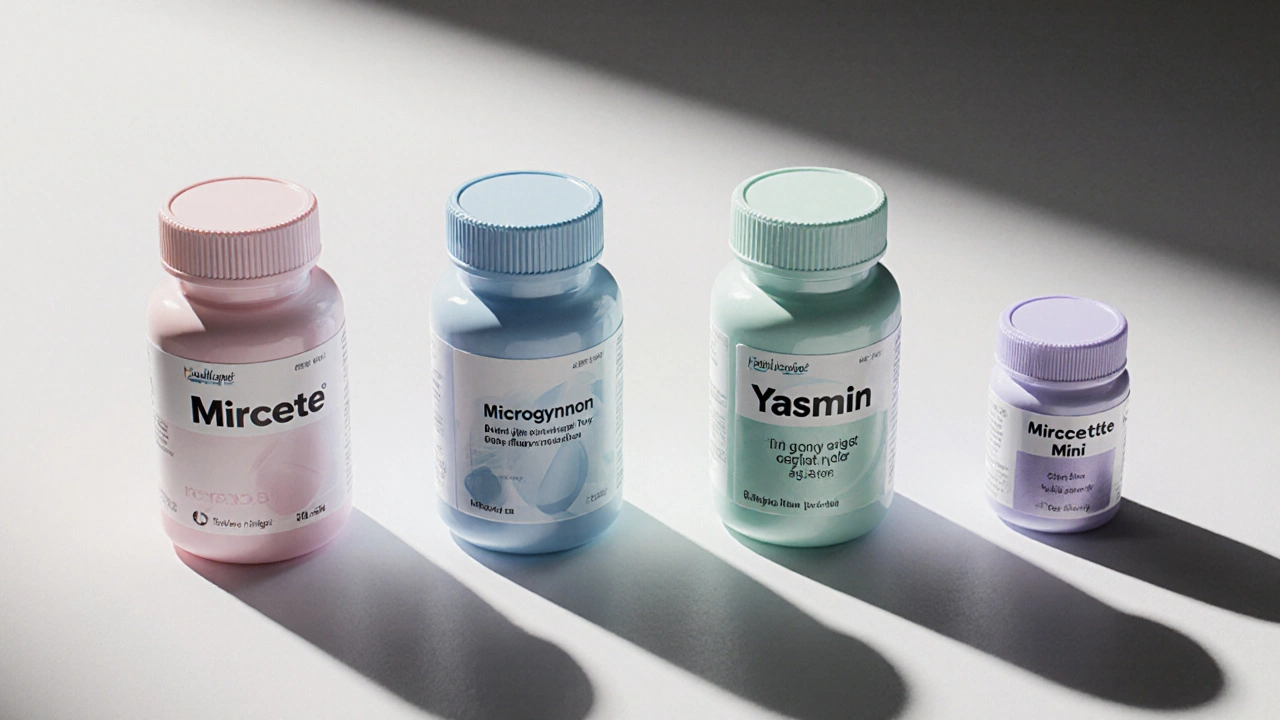Birth Control Method Selector
This tool helps identify appropriate birth control options based on your health profile and preferences. Always consult with a healthcare provider for personalized medical advice.
Your recommendations will appear here based on your selections.
Unintended pregnancy rates in South Africa dropped by 12% after 2020, largely because more women are choosing reliable oral contraceptives. One of the most prescribed options is Mircette - a combined oral contraceptive that blends Ethinyl estradiol and Desogestrel in a 21‑day active/7‑day placebo cycle.
Quick Takeaways
- Mircette combines 30µg Ethinyl estradiol with 150µg Desogestrel for high cycle control.
- Alternatives vary in estrogen dose, progestin type, and side‑effect profile.
- Key decision factors: cardiovascular risk, acne tendency, and menstrual regularity.
- Women with migraine with aura or smoking over 15 cigarettes/day should avoid higher‑dose estrogen combos.
- Progestin‑only pills are the safest fallback for those unable to take estrogen.
How Mircette Works
Mircette belongs to the class of combined oral contraceptives (COCs). It prevents ovulation by suppressing the hypothalamic‑pituitary‑gonadal axis, thickens cervical mucus, and alters the endometrium to discourage implantation. The 21‑day active phase delivers a steady hormone level, while the 7‑day placebo triggers a withdrawal bleed that mimics a natural period.
Key Ingredients Explained
Ethinyl estradiol is a synthetic estrogen that stabilizes the uterine lining and reduces breakthrough bleeding. Doses below 35µg are considered low‑dose, which lowers the risk of blood clots without sacrificing contraceptive efficacy.
Desogestrel is a third‑generation progestin. It binds strongly to progesterone receptors, providing reliable ovulation inhibition while having a milder impact on androgen‑related side effects such as acne or hirsutism.
Popular Alternatives
Below are the most frequently prescribed COCs and progestin‑only options that compete with Mircette in South Africa.
- Levonorgestrel/Ethinyl estradiol (Microgynon) - 30µg estrogen, 150µg levonorgestrel.
- Drospirenone/Ethinyl estradiol (Yasmin) - 30µg estrogen, 3mg drospirenone; noted for anti‑androgenic effect.
- Norgestimate/Ethinyl estradiol (Ortho‑Tri‑Cyclen) - 35µg estrogen, 0.18mg norgestimate; often chosen for acne control.
- Desogestrel‑only pill (Mircette Mini) - 150µg desogestrel; suitable for estrogen‑intolerant users.
- Levonorgestrel‑only pill (Micronor) - 30µg levonorgestrel; minimal hormonal fluctuation.

Side‑by‑Side Comparison
| Brand | Estrogen Dose | Progestin Type | Typical Cycle‑Related Side Effects | Cardiovascular Risk | Special Benefits |
|---|---|---|---|---|---|
| Mircette | 30µg | Desogestrel (3rd gen) | Light spotting, rare weight gain | Low‑moderate (similar to other low‑dose COCs) | Reduced acne, minimal androgenic effect |
| Microgynon | 30µg | Levonorgestrel (2nd gen) | Breakthrough bleeding, possible mood swings | Low‑moderate | Well‑studied safety record |
| Yasmin | 30µg | Drospirenone (4th gen) | Less bloating, occasional potassium loss | Moderate - monitor for hypertension | Anti‑androgenic, good for severe acne |
| Ortho‑Tri‑Cyclen | 35µg | Norgestimate (3rd gen) | Spotting during first 2‑3 months | Low‑moderate | Proven to improve acne in clinical trials |
| Mircette Mini | None (progestin‑only) | Desogestrel | Irregular bleeding, possible spotting | Very low - suitable for high‑risk cardiovascular patients | Ideal for breastfeeding moms |
Decision Criteria - What to Consider When Choosing
- Cardiovascular health: Women over 35 who smoke should avoid estrogen‑containing pills, especially those with higher estrogen doses.
- Acne & skin concerns: 3rd‑generation progestins (Desogestrel, Norgestimate) tend to be less androgenic, helping clear skin.
- Menstrual regularity: If you need a predictable bleed, low‑dose COCs like Mircette provide the most stable cycle.
- Weight & mood: Individual response varies; many users report stable weight on Desogestrel‑based pills.
- Lactation: Progestin‑only options (Mircette Mini, Micronor) are recommended while breastfeeding.
Best‑Fit Scenarios
Best for: Women aged 20‑35 seeking reliable contraception, mild acne control, and a regular monthly bleed without high estrogen exposure.
Not ideal for: Smokers over 35, those with a history of deep‑vein thrombosis, or women who experience severe mood swings on combined pills.
Potential Side Effects & How to Manage Them
- Breakthrough spotting: Usually resolves after 2-3 months; taking the pill at the same time daily helps.
- Nausea: Take with food or at bedtime; if persistent, discuss a lower‑dose option.
- Headaches: Monitor frequency; hormonal migraines may need a switch to a progestin‑only pill.
- Weight changes: Most users report no significant change; maintain a balanced diet and regular exercise.
Frequently Asked Questions
Frequently Asked Questions
Can I switch from Mircette to a progestin‑only pill?
Yes. A 7‑day buffer of combined pills is recommended before starting a progestin‑only pill to maintain contraceptive coverage.
Is Mircette safe for women with a history of blood clots?
No. Anyone with a past thrombotic event should avoid estrogen‑containing COCs and consider non‑hormonal methods or progestin‑only options.
How quickly does Mircette become effective?
If started within the first 5 days of your menstrual period, protection begins immediately. Otherwise, use a backup method for the first 7 days.
Can I take Mircette while breastfeeding?
It is generally discouraged for the first 6 weeks postpartum because estrogen can reduce milk supply. A progestin‑only pill is preferred.
What should I do if I miss a Mircette pill?
Take the missed pill as soon as you remember, then continue the pack normally. If you miss two or more active pills, use backup contraception for 7 days.
Bottom Line
When you weigh efficacy, side‑effect profile, and personal health factors, Mircette often emerges as a solid middle‑ground choice for young, healthy women who want reliable contraception and mild acne control. However, alternatives like Yasmin or a progestin‑only pill may fit better for those with specific cardiovascular concerns or breastfeeding needs. Always discuss your medical history with a healthcare professional before starting or switching any hormonal method.


Jenny Newell
October 15, 2025 AT 18:30The pharmacodynamic profile of Mircette is adequately summarized, yet the article skirts over the nuanced risk stratification for thromboembolic events in smokers. A more granular discussion on estrogen dose‑dependent coagulopathy would elevate the utility.
Kevin Zac
October 16, 2025 AT 13:57Great breakdown! I appreciate how the guide juxtaposes Mircette against both second‑generation and fourth‑generation combos, making the decision matrix clear for clinicians. If you could add a quick reference chart for contraindications in patients over 35, it would be even more user‑friendly.
Bianca Fernández Rodríguez
October 17, 2025 AT 09:23Honestly, this guide is overrated. It pretends to be exhaustive but most of the data is outdated, and it ignores the fact that many women experienc severe mood swings on any COC-MirCette included. The author should've at least mentioned the newer low‑dose patches.
Patrick Culliton
October 18, 2025 AT 04:50I'm going to call this out: presenting Mircette as a "solid middle‑ground" is misleading when the cardiovascular risk profile is practically identical to older formulations that have been phased out. If you’re looking for safety, stick with progestin‑only options.
Andrea Smith
October 19, 2025 AT 00:17Thank you for this comprehensive comparison. The articulation of both hormonal mechanisms and practical considerations offers a valuable resource for patients navigating contraceptive choices. Your emphasis on individualized assessment aligns perfectly with evidence‑based practice.
Claire Mahony
October 19, 2025 AT 19:43The analysis is thorough, though I would caution readers to weigh the trade‑offs of acne control versus potential metabolic effects. Overall, the guide succeeds in clarifying the spectrum of options without overwhelming jargon.
Andrea Jacobsen
October 20, 2025 AT 15:10I found the side‑effect table especially helpful; it gives a quick visual cue for common concerns like spotting or nausea. Adding a note on the impact of gastrointestinal disorders on absorption would round it out nicely.
Andrew Irwin
October 21, 2025 AT 10:37It’s good to see a balanced presentation that respects both patient preference and clinical safety. Encouraging shared decision‑making can only improve adherence and satisfaction.
Dylan Mitchell
October 22, 2025 AT 06:03OMG, this article is lit! But seriously, the author keeps mixing up “progestin” and “progesterone”-that's a basic error that shouldn't slip through. Keep an eye on your terminology, folks.
John Chapman
October 23, 2025 AT 01:30When evaluating combined oral contraceptives, it is imperative to consider both the pharmacokinetic parameters of the estrogen component and the receptor affinity profile of the progestin moiety. Ethinyl estradiol, at a 30 µg dose, offers a well‑characterized suppression of the hypothalamic‑pituitary‑gonadal axis with a relatively low incidence of hepatic protein synthesis up‑regulation. Desogestrel, as a third‑generation progestin, distinguishes itself through a reduced androgenic footprint, thereby mitigating acne and hirsutism in susceptible individuals. Nonetheless, the literature indicates a modestly elevated risk of venous thromboembolism relative to second‑generation levonorgestrel, a nuance that warrants explicit discussion in any comparative guide. Moreover, the cardiovascular risk stratification must integrate patient‑specific variables such as smoking status, body mass index, and age over 35, given the synergistic pro‑thrombotic effects observed in epidemiological cohorts. The withdrawal bleed elicited by the 7‑day placebo phase, while physiologically benign, can nonetheless be a source of anxiety for patients unacquainted with cyclic hormone withdrawal. In contrast, progestin‑only formulations like Mircette Mini eliminate estrogen‑mediated clotting concerns but introduce irregular bleeding patterns that may affect quality of life. Comparative efficacy, measured by Pearl Index, remains statistically indistinguishable across low‑dose COCs, underscoring that side‑effect profiles, rather than contraceptive failure rates, should dominate prescribing decisions. The guide’s inclusion of drospirenone‑containing Yasmin is commendable, yet it omits the associated risk of hyperkalemia, particularly in patients on concurrent antihypertensives. From a pharmacoeconomic perspective, generic formulations of levonorgestrel/ethinyl estradiol demonstrate superior cost‑effectiveness, a factor of undeniable relevance in resource‑constrained settings. While the author rightly highlights acne control as a benefit of third‑generation progestins, the mechanistic basis-namely reduced 5α‑reductase activity-deserves a brief exposition. Finally, patient counseling should emphasize adherence timing, as a 12‑hour window for missed doses can preserve contraceptive efficacy across most regimens. By integrating these multidimensional considerations, clinicians can tailor contraceptive therapy to optimize safety, tolerability, and patient satisfaction. This level of detail transforms a superficial comparison into a clinically actionable decision‑aid.
Matt Cress
October 23, 2025 AT 20:57Wow, thanks for the novel dissertation, Dr. Expert. Next, you’ll tell us the exact molecular weight of every pill’s binder.
Paige Crippen
October 24, 2025 AT 16:23Interesting take, though one can’t ignore how big pharma subtly steers these guides to push their flagship brands, keeping cheaper alternatives out of sight.
sweta siddu
October 25, 2025 AT 11:50Love the depth! 😊 This will help many women make informed choices, especially when navigating the maze of side‑effects. 👍